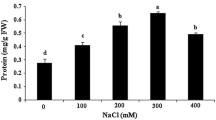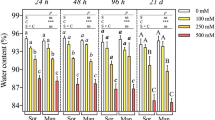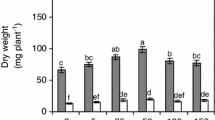Abstract
The effects of NaCl and mannitol iso-osmotic stresses on calli issued from sugarcane cultivars (cvs.) R570, CP59-73 and NCo310 were investigated in relation to callus growth, water content, ion and proline concentrations. Callus growth and water content decreased under both stresses with the highest reduction under mannitol-induced osmotic stress. The ion concentration was drastically affected after exposure to NaCl and mannitol. Salt stress induced an increase in Na+ and Cl− accumulation and a decrease in K+ and Ca2+ concentrations. Under mannitol-induced osmotic stress, K+ and Ca2+ concentrations decreased significantly while Na+ and Cl− concentrations remained unchanged. Free proline accumulation occurred under both stresses and was more marked in stress-sensitive cv. than in stress-resistant one. Our results indicated that the physiological mechanisms operating at the plant cell level in response to salt- and osmotic-induced stress in sugarcane cvs. are different. Among the cvs., we concluded that the stress resistance is closely related to the maintain of an adequate water status and a high level of K+ and Ca2+ under both stresses and a low level of Na+ concentration in the presence of NaCl. Thus, sugarcane (Saccharum sp.) can be regarded as a Na+ excluder. We also provided evidence that proline accumulation is a stress-sensitive trait rather than a stress resistance marker.







Similar content being viewed by others
Abbreviations
- 2,4-D:
-
2,4-Dichlorophenoxyacetic acid
- cv(s):
-
Cultivars
- MS:
-
Murashige and Skoog
- RGR:
-
Relative growth rate
- ANOVA:
-
Analyses of variance
References
Alvarez I, Tomaro LM, Benavides MP (2003) Changes in polyamines, proline and ethylene in sunflower calluses treated with NaCl. Plant Cell Tissue Organ Cult 74:51–59
Ashraf M, Harris PJC (2004) Potential biochemical indicators of salinity tolerance in plants. Plant Sci 166:3–16
Bajji M, Lutts S, Kinet JM (2000) Physiological changes after exposure to and recovery from polyethylene glycol-induced water deficit in callus cultures issued from durum wheat (Triticum durum Desf.) cultivars differing in drought resistance. J Plant Physiol 156:75–83
Basu S, Gangopadhyay G, Mukherjee BB (2002) Salt tolerance in rice in vitro: implication of accumulation of Na+, K+ and proline. Plant Cell Tissue Organ Cult 69:55–64
Bates LS, Waldren RP, Teare ID (1973 Rapid determination of free proline for water-stress studies. Plant Soil 39:205–207
Benlloch-Gonzàlez M, Fournier JM, Ramos J, Benlloch M (2005) Strategies underlying salt tolerance in halophytes are present in Cynara cardunculus. Plant Sci 168:653–659
Cano EA, Perez-Alfocea F, Moreno V, Bolarin MC (1996) Responses to NaCl stress of cultivated and wild tomato species and their hydrids in callus cultures. Plant Cell Rep 15:791–794
Chinnusamy V, Zhu JK (2003) Plant salt tolerance. Top Curr Genet 4:241–270
Delauney AJ, Verma DPS (1993) Proline biosynthesis and osmoregulation in plants. Plant J 4:215–223
Dutta Gupta S, Auge RM, Denchev PD, Conger BV (1995) Growth, proline accumulation and water relations of NaCl-selected and non-selected callus lines of Dactylis glomerata L. Environ Exp Bot 35:83–92
Ehsanpour AA, Fatahian N (2003) Effects of salt and proline on Medicago sativa callus. Plant Cell Tissue Organ Cult 73:53–56
Flowers TJ, Yeo AR (1995) Breeding for salinity resistance in crop plants; what the next? Aust J Plant Physiol 22:875–884
Garcia AB, Engler JDA, Iyer S, Gerats T, Montagu MV, Caplan AB (1997) Effects of osmoprotectants upon NaCl stress in rice. Plant Physiol 115:159–169
Greenway H, Munns R (1980) Mechanisms of salt tolerance in nonhalophytes. Annu Rev Plant Physiol 31:149–190
Grattan SR, Grieve CM (1999) Salinity-mineral nutrient relations in horticultural crops. Sci Hortic 78:127–157
Guerrier G, Patolia JS (1989) Comparative salt responses of excised cotyledons and seedlings of pea to various osmotic and ionic stresses. J Plant Physiol 135:330–337
Hasegawa P, Bressan RA, Zhu JK, Bohnert HJ (2000) Plant cellular and molecular responses to high salinity. Annu Rev Plant Mol Biol 51:463–499
Hirschi KD (2004) The calcium conundrum. Both versatile nutrient and specific signal. Plant Physiol 136:2438–2442
Lerner HR (1985) Adaptation to salinity at the plant cell level. Plant Soil 89:3–14
Lutts S, Almansouri M, Kinet JM (2004) Salinity and water stress have contrasting effects on the relationship between growth and cell viability during and after stress exposure in durum wheat callus. Plant Sci 167:9–18
Lutts S, Kinet JM, Bouharmont J (1996a) Effects of salt stress on growth, mineral nutrition and proline accumulation in relation to osmotic adjustment in rice (Oryza sativa L.) cultivars differing in salinity resistance. Plant Growth Regul 19:207–218
Lutts S, Kinet JM, Bouharmont J (1996b) Effects of various salts and of mannitol on ion and proline accumulation in relation to osmotic adjustment in rice (Oryza sativa L.) callus cultures. J Plant Physiol 149:186–195
Mohamed MAH, Harris PJC, Henderson J (2000) In vitro selection and characterisation of a drought tolerant clone of Tagetes minuta. Plant Sci 159:213–222
Munns R, Husain S, Rivelli AR, Richard A, James RA, Condon AGT, Lindsay MP, Lagudah ES, Daniel P, Schachtman DP, Hare RA (2002) Avenues for increasing salt tolerance of crops, and the role of physiologically based selection traits. Plant Soil 247:93–105
Murashige T, Skoog F (1962) A revised medium for rapid growth and bioassay with tobacco tissue cultures. Physiol Plant 15:473–497
Paquin R, Lechasseur P (1979) Observations sur une méthode de dosage de la proline libre dans les extraits de plante. Can J Bot 57:1851–1854
Parida KA, Das AB (2005) Salt tolerance and salinity effects on plants. Ecotoxicol Environ Saf 60:324–349
Rus AM, Panoff M, Perez-Alfocea F, Bolarin MC (1999) NaCl responses in tomato calli and whole plants. J Plant Physiol 155:727–733
Sacchi AG, Morgutti S, Abruzzese A, Alisi C, Cocucci M, Espen L, Leva RA, Muleo R, Cocucci MS (1995) Changes in some physiological and biochemical parameters during two subcultures in Kiwi (Actinidia deliciosa) callus. Plant Sci 106:107–113
Sairam RK, Tygai A (2004) Physiology and molecular biology of salinity stress tolerance in plants. Curr Sci 86:407–421
SAS Institute Inc. (1988) SAS/STATJ User’s Guide. Release 6.03 edn. SAS Institute Inc., Cary, NC, p.1028
Tonon G, Kevers C, Faivre-Rampant O, Graziani M, Gaspar T (2004) Effect of NaCl and mannitol iso-osmotic stresses on proline and free polyamine levels in embryogenic Fraxinus angustifolia callus. J Plant Physiol 161:701–708
Trivedi S, Galiba G, Sankhla N, Erdei L (1991) Responses to osmotic and NaCl stress of wheat varieties differing in drought and salt tolerance in callus cultures. Plant Sci 73:227–232
Trotel P, Bouchereau A, Niogret MF, Larher F (1996) The fate of osmoaccumulated proline in leaf discs of rape (Brassica napus L.) incubated in a medium of low osmolarity. Plant Sci 118:31–45
Wahid A, Rao AR, Rasul E (1997) Identification of salt tolerance traits in sugarcane lines. Field Crops Res 54:9–17
Watanabe S, Kojima K, Ide Y, Sasaki S (2000) Effects of saline and osmotic stress on proline and sugar accumulation in Populus euphratica in vitro. Plant Cell Tissue Organ Cult 63:199–206
Zhu JK (2001) Plant salt tolerance. Trends Plant Sci 6:66–71
Acknowledgments
The authors are very grateful to D. El Ghrassli (Centre Technique des Cultures Sucrières, Morocco) for kindly providing the sugarcane cultivars. This research was financially supported by funds of Programme d’Appui à la Recherche Scientifique (PARS AGRO 180) from the Ministère de l’Enseignement Supérieur, de la Formation des Cadres et de la Recherche Scientifique of Morocco.
Author information
Authors and Affiliations
Corresponding author
Additional information
Communicated by M. Filek.
Rights and permissions
About this article
Cite this article
Errabii, T., Gandonou, C.B., Essalmani, H. et al. Effects of NaCl and mannitol induced stress on sugarcane (Saccharum sp.) callus cultures. Acta Physiol Plant 29, 95–102 (2007). https://doi.org/10.1007/s11738-006-0006-1
Received:
Accepted:
Published:
Issue Date:
DOI: https://doi.org/10.1007/s11738-006-0006-1




